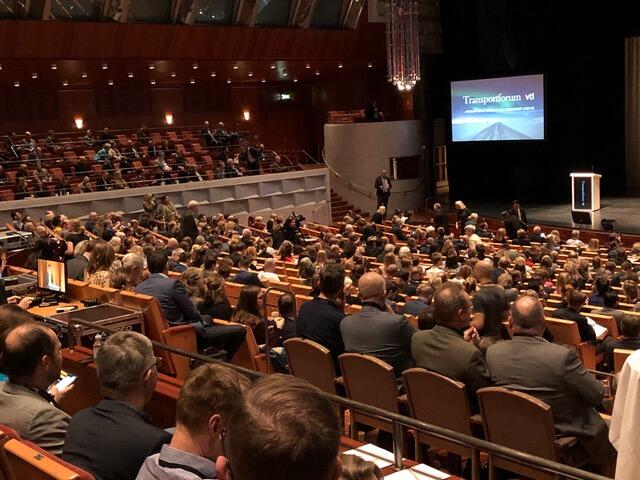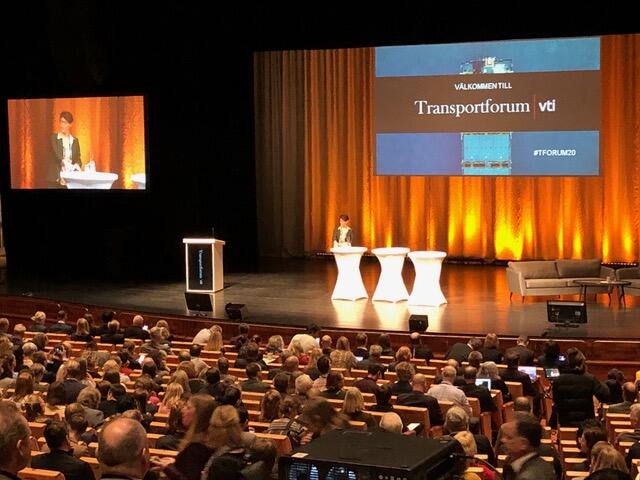Results from Triple F´s establishment project were presented during Transportforum
Johanna Takman, postgraduate and research assistant at VTI, presented results from System-Wide Follow-Up (Systemövergripande Uppföljning), which is Triple F's establishment project, during Transportforum in Linköping.

The purpose of the project is to develop a consistent follow-up system with indicators that show how the freight transport sector is approaching the Swedish goal of reducing the transport sector's emissions of greenhouse gases by 70% between 2010 and 2030. The presentation shows a selection of the indicators that were identified in the project and were discussed in the sub-report of System-Wide Follow-Up that was published in October 2019. However, several of the indicators in the report are updated in the presentation with new statistics for greenhouse gas emissions in 2018.
Freight carriers' greenhouse gas emissions have decreased by 21.3% between 2010 and 2018, which is somewhat less than the 28% that the greenhouse gas emissions would have had to decrease in order to achieve the goal by 2030 at a linear rate. In other words, greenhouse gas emissions need to decrease at a somewhat faster rate in order to achieve the 2030 goal. By 2018, the trucks would have had to reduce their greenhouse gas emissions by 28.5% in order to reduce greenhouse gas emissions by 70% at a linear rate between 2010 and 2030. Instead, the greenhouse gas emissions of domestic maritime shipping increased by 8.8% by 2018, based on a new calculation method for maritime greenhouse gas emissions. Until 2013, the development for greenhouse gas emissions and freight transport work (tonne-kilometer) proceeded in parallel for trucks, but after 2013 the development shows a potential interruption of the trend where transport work increases while greenhouse gas emissions decrease.
Triple F focuses on three overall challenges to the reduction of greenhouse gas emissions: transition to energy-efficient vehicles and vessels, a more transport-efficient society, and an increased share of renewable fuel. With respect to moving freight transport from the road to rail and waterway, very little has happened since 2010. However, there is still potential for an accelerated transition. The main requirement for the switching from the road to rail or waterway is a distance greater than 300 km. In 2018, 9% of all cargo transported in Sweden traveled distances greater than 300 km, which is equivalent to 41% of all tonne-kilometres.
Examples of improved efficiency in the freight transport sector can include increasing the capacity utilisation, coordination and combined cargo transport, technical development, etc. Many of those factors are, however, difficult to measure and there are several gaps in the statistics in this area, which complicates the possibility of following up on how improved efficiency contributes to the 2030 goal. Nevertheless, a few indicators have been identified in the System-Wide Follow-Up. For instance, the average amount of cargo transported for trucks decreased by 0.6 tonnes per truck between 2010 and 2017, which could indicate that shipments by truck have become less efficient over the time period. Instead, the energy intensity for road shipments (including transportation of people) has decreased over time, which indicates that transport by road has become more efficient.
Since 2010, the share of renewable fuel has increased substantially in Sweden. It is primarily the use of HVO that has contributed to this increase. HVO is used primarily in buses and trucks, which indicates that the share of renewable energy for lorries may be even higher than for the road transport sector as a whole. However, there are no statistics available on the share of renewable fuel for freight transport. The increase of the share of renewable energy in the domestic transport sector is one of the clearest changes among the indicators in the System-Wide Follow-Up. It can, therefore, be concluded that increased share of renewable energy has played an important role in the reduction of greenhouse gas emissions by lorries over the time period.
Several major gaps in the statistics have been identified in the study. Statistics that would be beneficial for a better understanding of freight transport's conversion to fossil-freedom include: renewable fuel for freight transport, freight transport work for light lorries, cargo capacity utilisation and other measurements of efficiency for all modes of transportation, capacity utilisation of transshipment terminals and emissions data that shows greenhouse gas emissions for freight transport and not just greenhouse gas emissions classified by type of traffic.


